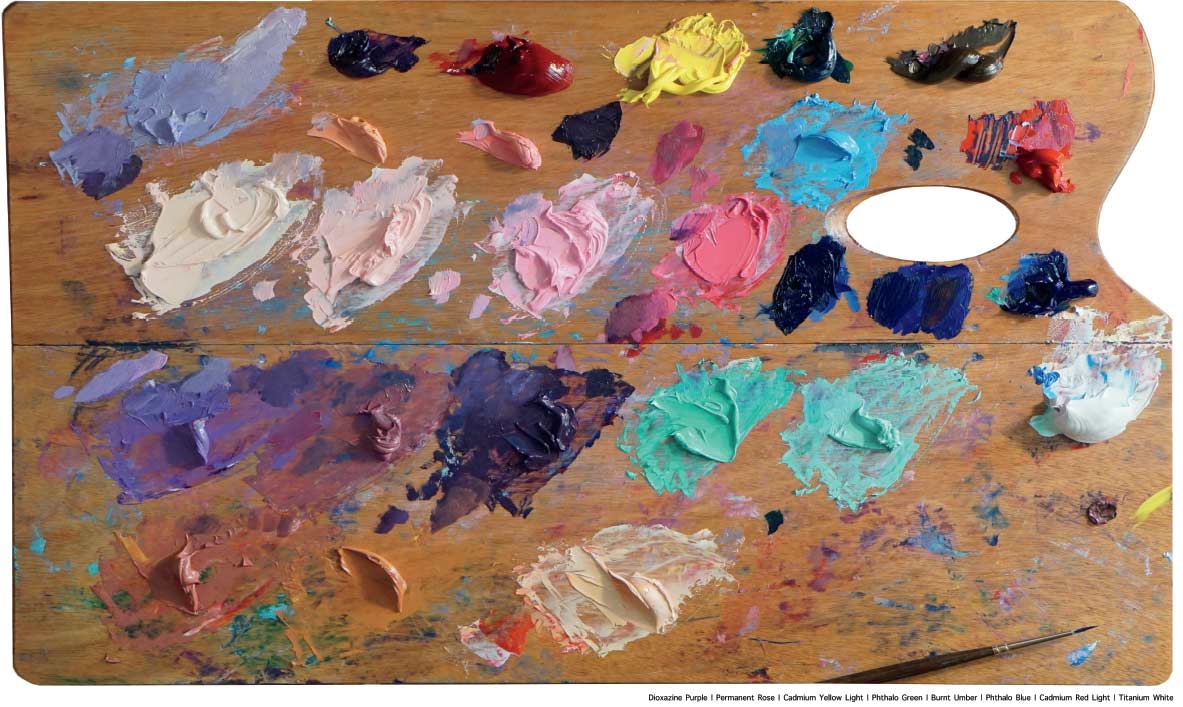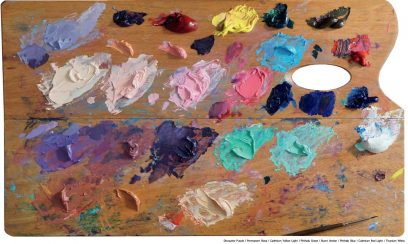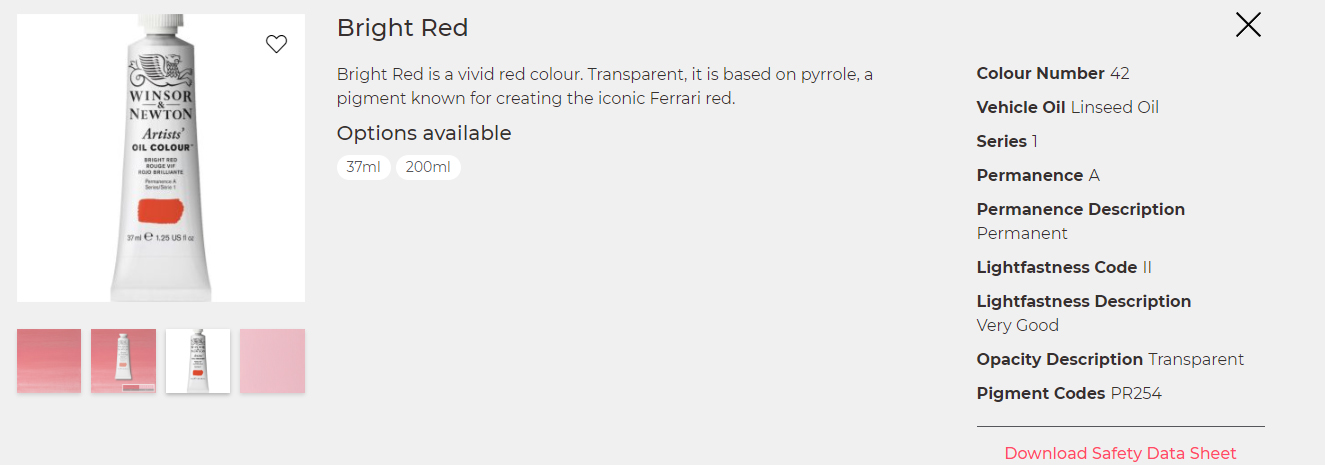
Whether you use a glazing technique in your paintings, or alla prima, you might want to know if the pigments you use are opaque or not. This is where a list of transparent and opaque pigments can come in handy. I put together this list many years ago for my basic painting course at The Art League and at Georgetown University. Now I’m making it available for you to use. If you don’t see a pigment, let me know in the comments and I will add it to the list!
How did I come up with this list?
This list is based on Winsor Newton’s Artist’s oil paint list (Winton student grade list is here). As such, it relies on their qualifications and standards of what is opaque and what is transparent. With that said, judging whether a pigment is opaque or transparent is relative and will depend on a few factors unique to your own situation.
- Brand of pigments. Some pigments can appear wildly different from one brand to the next. Including their opacity. Professional vs student grade paints for example, have a slightly different chemical makeup, and this may effect the pigment’s coverage. More expensive brands may also have a higher pigment percentage than less expensive alternatives.
- Thickness of the paint applied. Thicker paint will naturally appear more opaque than thinner applications, or pigment mixed with medium.

- The type of brush you use: Some less expensive brushes sweep the paint away instead of softly laying the paint down. Bristle hair bushes for example, tend to brush through the paint film, and softer synthetic brushes and high quality sable will lay the paint down and allow it to cover uniformly, appearing less thin.
- The Support: If your support is rigid and smooth, the paint film sometimes goes on thinner and appears more transparent and scratchy . A rougher and more porous texture may require more paint and therefore appear less transparent. (The glass photo and video illustrates how the rigid surface really shows the mark)
The List of Transparent and Opaque Oil Pigments
This list below is based on Winsor Newton’s Artist’s oil paint list (Winton student grade list is here).
| T – Transparent | ST – Semi Transparent | SO – Semi Opaque | O – Opaque |
| Pigment Name | Opacity | Pigment Name | Opacity |
|---|---|---|---|
| Alizarin Crimson | T | Payne’s Grey | ST |
| Aureolin | T | Permanent Green | T |
| Bismuth Yellow | O | Permanent Green Deep | ST |
| Blue Black | SO | Permanent Green Light | ST |
| Bright Red | T | Permanent Magenta | T |
| Brown Madder | T | Phthalo Blue | T |
| Bronze | SO | Phthalo Turquoise | T |
| Burnt Sienna | T | Prussian Blue | T |
| Burnt Umber | T | Purple Lake | T |
| Charcoal Grey | ST | Purple Madder | T |
| Chrome Green Deep Hue | O | Prussian Green | T |
| Chrome Yellow Hue | SO | Permanent Alizarin Crimson | T |
| Cerulean Blue | SO | Permanent Mauve | ST |
| Cobalt Blue Deep | ST | Permanent Sap Green | T |
| Cobalt Turquoise | O | Permanent Rose | T |
| Carmine | T | Pewter | SO |
| Cobalt Green | SO | Purple Madder | T |
| Cobalt Green Deep | O | Rose Doré | T |
| Cobalt Violet | ST | Rose Madder Deep | T |
| Cadmium Green | O ! | Rose Madder Genuine | T |
| Cadmium Green Pale | O ! | Renaissance Gold | SO |
| Cadmium Lemon | O ! | Raw Sienna | ST |
| Cadmium Orange | O ! | Raw Umber | ST |
| Cadmium Red | O ! | Sap Green | T |
| Cadmium Red Deep | O ! | Scarlet Lake | SO |
| Cadmium Scarlet | O ! | Silver | SO |
| Cadmium Yellow | O ! | Transparent Yellow | T |
| Cadmium Yellow Pale | O ! | Transparent Gold Ochre | T |
| Cadmium Yellow Deep | O ! | Terra Rosa | O |
| Copper | SO | Terre Verte | T |
| Cobalt Blue | ST | Ultramarine Green Shade | T |
| Davy’s Grey | ST | Ultramarine Violet | T |
| Flesh (no one is this color) Tint | O | Vandyke Brown | T |
| French Ultramarine ( Ultramarine Blue ) | T | Venetian Red | O |
| Gold | SO | Viridian | T |
| Gold Ochre | O | Vermilion Hue | O ! |
| Indian Red | O | Winsor Blue (Green Shade) | T |
| Indian Yellow | T | Winsor Blue (Red Shade) | T |
| Indigo | T | Winsor Emerald | O |
| Indanthrene Blue | T | Winsor Green (phthalo) | T |
| Ivory Black | SO | Winsor Green (Yellow Shade) | T |
| Lamp Black | O | Winsor Lemon | ST |
| Light Red | O | Winsor Orange | SO |
| Lemon Yellow Hue (Nickel Titanate) | O | Winsor Red | SO |
| Manganese Blue Hue | T | Winsor Red Deep | ST |
| Mauve (Blue Shade) | T | Winsor Violet (Dioxazine) | T |
| Mars Black | O | Winsor Yellow Deep | ST |
| Mars Violet Deep | O | Winsor Yellow | ST |
| Naples Yellow Light | O | Yellow Ochre Pale | O |
| Naples Yellow | O ! | Yellow Ochre | ST |
| Olive Green | T | Yellow Ochre Light | ST |
| Oxide of Chromium | O |


Great list Scott! Exactly the reference I wanted, Much oblidged.
Your quite welcome! I’m glad you found it useful.
Just what I was looking for. I have Williamsburg’s. Fanchon red, Permanent yellow light and medium, Vinidian, Naples yellow Italian, Titanium white, Ultramarine blue?
Hello Shell, You might find the Williamsburg website useful for you. Their list of pigments list is here. https://www.williamsburgoils.com/pigment_chart
My color chart is based on Winsor Newton’s pigments. But I did look up those colors. Fanchon red, Permanent yellow light and medium are Semi-Opaque, Viridian is Semi-Transparent, Naples yellow Italian and Titanium white is Opaque, Ultramarine Blue is Transparent.
Hey there, W&N Bright Red is opaque, not transparent. The pigment is PR254, pyrrole red.
Lynne
Hello,
The transparent designation is based on Winsor Newton’s website.
https://www.winsornewton.com/int/paint/oil/artists-oil/?attribute_pa_wn_colour_name=bright-red&attribute_pa_wn_colour_size=37ml&sku=50904006
Thank you Scott. As a newbie oil painter your list was so helpful!
Thank you, that’s so great to hear!
Thank you Scott for this list. However I have several Wintonoil clors from your list, bought the other day a d they ate clearly marked as transparent while you list them as opaque?
Hello Milan,
My list has been compiled from Winsor Newton’s Artist’s oils, not Winton. The list on their site for Winton is here: https://www.winsornewton.com/na/education/composition-permanence/artists-oil-colour/ . I will make a note of that in my article.
Thanks for the list! Love the flesh comment.
Just starting & wondered how to handle the hazardous cadmium paints. Affects breathing or touch?
You can read the Osha data sheet for Cadmium here: https://www.osha.gov/sites/default/files/publications/osha3136.pdf In short: “Workers face a greater danger of cadmium exposure from inhalation than from ingestion. Exposure to cadmium…in jobs in which workers are exposed to cadmium dust or fumes, where they heat compounds or surfaces that contain cadmium, or where workers weld or cut with materials or solders that contain cadmium.” My take: I would be careful not to sand, scrape or cut a surface in which you have used Cadmium paints. Using gloves may also be good to help keep you from ingesting the paint.
Thank you, just what I wanted!
So useful. Thanks from Devon, England. Maybe we are pale flesh-coloured here?! Actually I am Scottish so my husband says I am have blue skin, it takes 2 weeks of sun to turn flesh coloured,🤣
This helps a lot. Please add the following seven colors to your list: Carbon Black, Mars Black, Quinacridone Magenta, Chromium Oxide Green, Dioxazine Purple, Cerulean Blue, and Emerald Green. Thank you!
Excellent work. Have you had any problems with different manufacturers of pigment? or who is your first choice of pigment
My first choice has always been Winsor & Newton. Not to be confused with their less expensive grade “Winton”. Mainly because I am used to how the colors mix and their saturation/power. I also like that they have been making paints for almost 200 years.
Thank you very much, Scott. I was gonna run out and buy more paint, but with your chart I discovered I had in my stash just what I needed. Thank you and I wish you a very Happy New Year.
Very informative. Thanks
Oh man this is definitely going on my home screen! This is so awesome! Thank you ever so much for making this!
Thank you for the list, I am using Winsor and Newton Water based oils as I have become allergic to the turps and other chemicals. I find they work exactly like oil paints but am not sure of the opaque/transparency ? Denise from Australia
You can find that list here: https://www.winsornewton.com/na/education/composition-permanence/artisan-water-mixable-oil-colour/
Pingback: Researching transparent vs non transparent pigments – Emma Ferrer's Art Blog
Pingback: 7 Ways To Use Acrylic Paint To Create Transparency And Dimension | Painting Facts
Pingback: Bonding Acrylic Paint With Acrylic Sheets | Painting Facts
Pingback: Gouache vs. Watercolor: Unveiling the Differences | Painting Facts